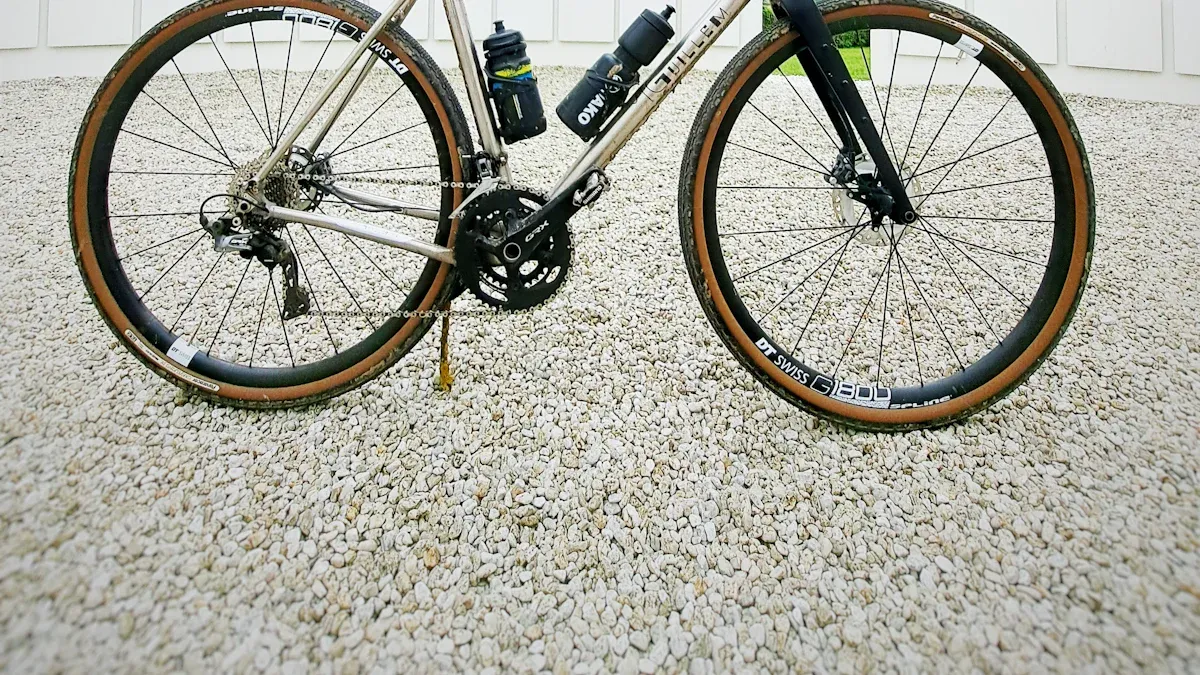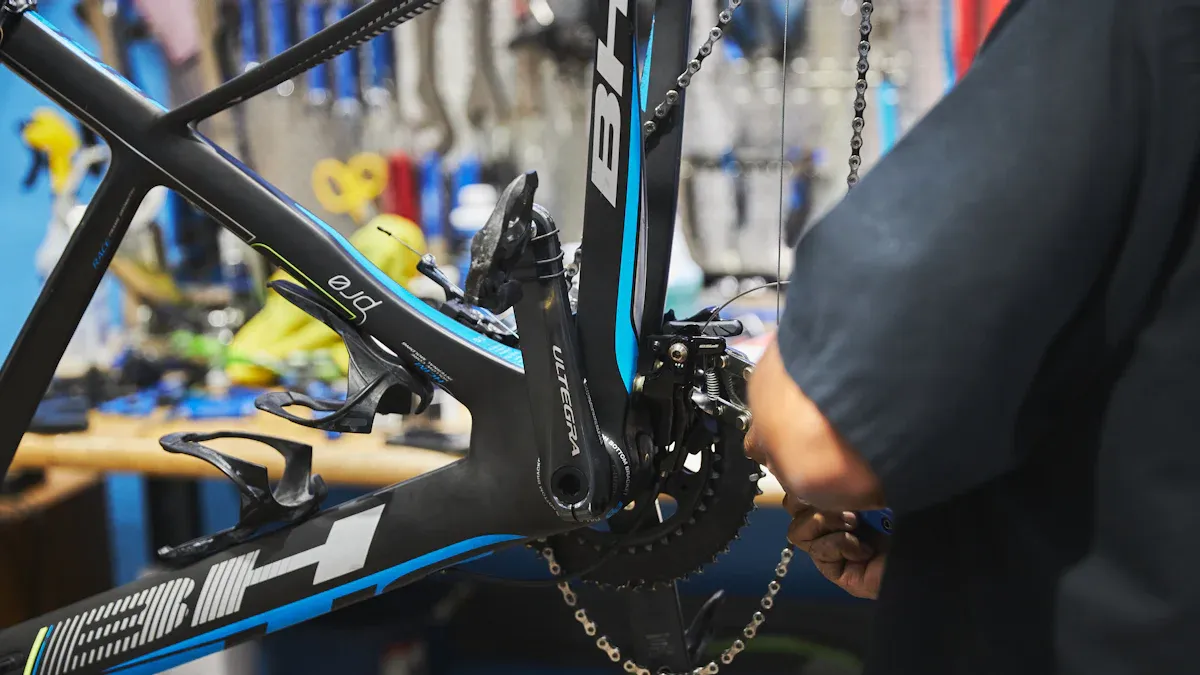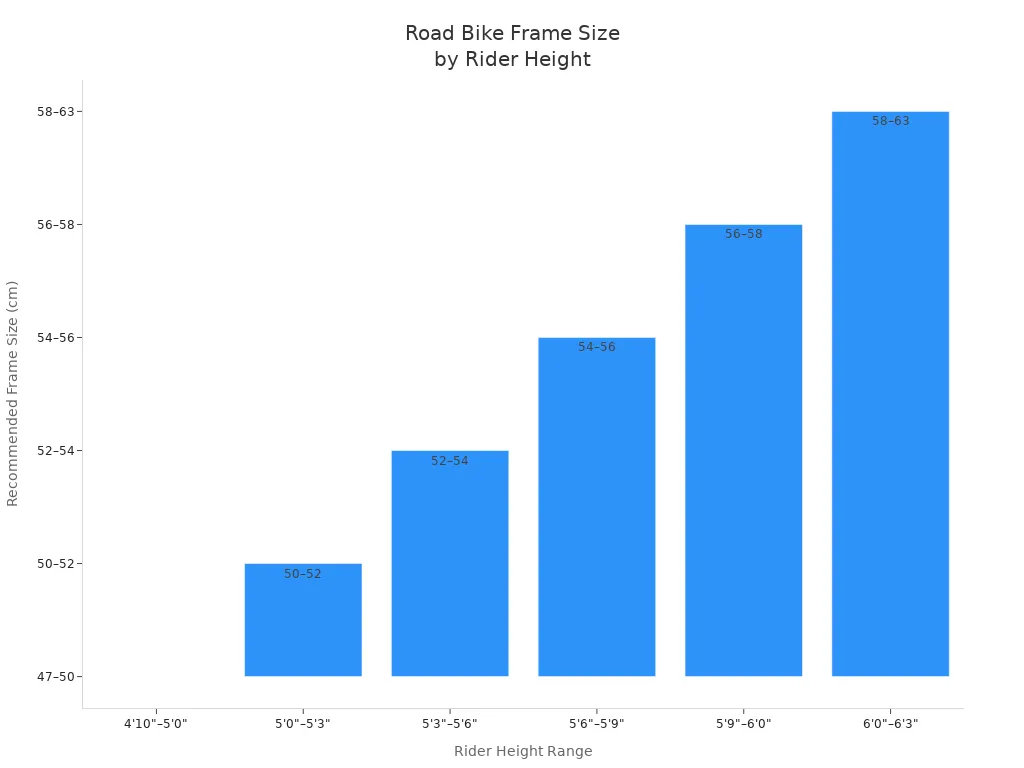
You need the right road bike frame size for a safe and comfortable ride. A good fit helps you keep a healthy posture and prevents pain in your back, neck, and knees. You feel more in control and can pedal with less effort. Choosing the correct road bike frame size boosts your riding experience and keeps you moving smoothly.
Key Takeaways
Picking the right road bike frame size keeps you comfy and stops pain in your back, knees, and shoulders. A good bike fit lets you ride longer and feel less tired because you use your energy better. Changing the saddle height, handlebar spot, and reach helps your riding posture and power. Using size charts, measuring your body, and trying out bikes help you pick the best frame size. Getting a pro bike fitting gives the best fit and helps you stay safe and ride better.
Road Bike Frame Size and Comfort

Posture and Pain Prevention
You need the right bike frame size to keep a healthy riding position. When you choose a frame size that matches your body, you can sit with your back straight and your shoulders relaxed. This helps you avoid pain in your neck, knees, and lower back. A scientific study found that adjusting road bike frame size changes how your joints and muscles work. The researchers measured how different frame sizes affected riders’ posture and found that the right fit improves comfort and reduces pressure on your body. If you ride a bike with the wrong frame size, you may feel soreness or even develop injuries over time. You can prevent pain by making sure your bike frame size matches your height, leg length, and reach.
Tip: If you feel pain in your knees or shoulders after riding, check your bike frame size and fitting. Small changes can make a big difference in your comfort.
Reducing Fatigue
You can ride longer and feel less tired when your bike frame size fits you well. A proper fit keeps your muscles working in the best position, so you use less energy with each pedal stroke. Studies show that ergonomic adjustments to bike frame size and fitting help lower pain and fatigue, even when you ride more often. When your position on the bike is correct, your body does not have to fight against awkward angles or reach too far. This means you can enjoy a comfortable ride and focus on your speed and distance. If your bike frame size is too big or too small, you may get tired quickly and lose interest in riding.
Here is a simple table showing how frame size affects fatigue:
Frame Size Match | Fatigue Level | Comfort |
|---|---|---|
Correct | Low | High |
Too Small | High | Low |
Too Large | High | Low |
Ergonomic Position
You need an ergonomic position to stay comfortable and safe on your bike. Bike fitting experts use ergonomic principles to set your saddle height, handlebar position, and reach. These steps help you find your optimal riding position, which balances comfort and power. The right bike frame size lets you adjust your position so your knees, hips, and shoulders line up naturally. This reduces strain and helps you avoid numbness or soreness. Your personal comfort preferences matter, too. You may want a slightly higher handlebar for a more relaxed position or a lower one for speed. Professional fitting can help you find the best position for your body and riding style.
Measure your height and inseam before choosing a road bike frame size.
Stand over the bike to check for enough clearance.
Adjust the saddle and handlebars to match your comfortable riding posture.
You can enjoy a comfortable ride and improve your performance when you pay attention to bike frame size and fitting. The right position keeps you safe and helps you ride with confidence.
Bike Fitting and Performance

Power Transfer
You want your pedaling to be strong. Good bike fitting helps you use energy well. When your saddle, cleats, and handlebars fit your body, you push harder on the pedals. Experts say putting your knee over the pedal spindle and setting your cleats right helps you get more power. Cyclists often feel stronger and less tired after these changes. You can improve your riding by checking your fit. This means your frame size matches your body, and your contact points line up. A good fit lowers injury risk and helps you ride longer and stronger.
Note: Small changes in how you sit can make a big difference in how well you pedal and ride.
Handling and Control
You need a bike that moves with you. Frame geometry affects how your bike handles. The angles and tube lengths change stability and how fast you turn. For example, a steeper head tube angle lets you steer quickly. A slacker angle makes your bike steady at high speeds. Short chainstays help you turn fast. Long chainstays keep you steady. The wheelbase matters too. A short wheelbase makes your bike easy to move. A long wheelbase helps you feel safe. Reach and stack change how you sit, balancing comfort and control.
Geometry Element | Effect on Handling and Control |
|---|---|
Head Tube Angle | Steeper = quick steering; Slacker = stable at speed |
Seat Tube Angle | Steeper = efficient pedaling; Slacker = comfort and stability |
Chainstay Length | Shorter = agile; Longer = stable |
Wheelbase | Shorter = maneuverable; Longer = stable |
Reach and Stack | Longer reach/lower stack = aerodynamic; Shorter reach/higher stack = comfort |
Speed and Efficiency
You want to go faster and use less energy. The right frame size and fit help you find the best position for speed. When your body lines up with your bike, you cut wind and pedal smoothly. Bike fitting experts say changing your position can make you faster and help you perform better. A well-fitted bike lets you ride longer and faster without getting tired. You can reach your goals and enjoy riding more when your bike fits your body and style.
Risks of Incorrect Road Bike Size
Injury and Discomfort
You put your body at risk when you ride an ill-fitting bike. The wrong road bike size can cause pain in your lower back, knees, neck, and shoulders. Many cyclists report lower back pain as the most common injury from poor bike fit. You may also feel knee pain or leg problems if your saddle or handlebars do not match your body. When your bike does not fit, your body tries to adjust, which leads to strain and overuse injuries. For example, a saddle that is too high or too low can hurt your knees. If your handlebars are too far away, your neck and shoulders may ache. Over time, these problems can turn into long-term health issues.
Improper frame size causes awkward riding positions and extra stress on your muscles and joints.
You may develop neck pain from holding your head at an odd angle.
Shoulder pain can happen if your arms stretch too far.
Gripping the handlebars too tightly may lead to elbow or wrist pain.
Numbness in your hands or feet can result from too much pressure on nerves.
Tip: Always check your road bike size and make small adjustments to avoid discomfort and injury.
Poor Handling
An ill-fitting bike makes it hard for you to control your ride. If your bike frame is too big or too small, you may struggle to steer or balance. You might notice that turning feels awkward or that you cannot reach the brakes easily. Poor handling can make you feel less confident, especially when riding fast or on busy roads. A bike that fits well lets you react quickly and ride smoothly. When your road bike size matches your body, you stay in control and enjoy a safer ride.
Reduced Safety
Safety drops when you use an ill-fitting bike. You may lose balance or react slowly in emergencies. If you cannot reach the handlebars or brakes, you risk falling or crashing. Long-term use of the wrong road bike size can also cause nerve damage or numbness, making it harder to sense danger. Studies show that poor bike fit increases the chance of repetitive strain injuries and discomfort. You protect yourself and ride with confidence when you choose the right frame size and adjust your bike to fit your needs.
Road Bike Sizing Guide
Key Measurements
You need to measure your body before you choose a road bike frame size. These measurements help you find the correct bike size and make sure your ride feels comfortable. Start by measuring your height. Stand straight against a wall and use a tape measure from the floor to the top of your head. Next, measure your inseam. Place your feet about six inches apart and measure from the floor to your crotch. This number helps you pick a frame size that matches your legs.
Check your standover height by straddling the bike. You should have at least one inch of clearance between your body and the top tube. This keeps you safe and helps you control the bike. Look at the seat tube length, which runs from the bottom bracket to the top of the seat tube. This affects how high you can set your saddle. Measure the top tube length to see how far you will reach to the handlebars. A longer top tube means you stretch out more, while a shorter one gives you a more upright position.
Stack is another important measurement. Stack is the vertical distance from the bottom bracket to the top of the head tube. It changes how high your handlebars sit and affects your posture. Reach is the horizontal distance from the bottom bracket to the handlebars. Reach and stack work together to decide how stretched or relaxed you feel on the bike. You want your leg almost straight at the bottom of each pedal stroke, but your knee should not lock. These measurements help you measure your bike frame size and find a correctly sized frame for your body.
Key Measurements Checklist:
Height
Inseam length
Standover height
Seat tube length
Top tube length
Stack
Reach
Leg extension
Headtube length
Tip: Write down your measurements and compare them to the bike’s geometry chart before you buy.
Using Size Charts
You can use manufacturer size charts to start your road bike sizing journey. Most charts use your height and inseam to suggest a frame size. These charts give you a rough idea, but they do not always match every rider. Brands use different ways to measure frame size, such as seat tube length, reach, and stack. You may notice that one brand’s medium frame feels different from another’s.
Size charts help you narrow down your choices, but you should not rely on them alone. Your arm span, riding style, and comfort matter too. If you like a more aggressive position, you might choose a smaller frame. If you want more comfort, a larger frame may suit you better. Online bike sizing calculators and local bike shops can help, but they cannot replace a real test ride or professional fitting.
Sizing Method | What It Uses | What It Misses |
|---|---|---|
Manufacturer Chart | Height, Inseam | Body proportions, comfort |
Online Calculator | Height, Inseam, Reach | Riding style, flexibility |
Shop Consultation | Height, Inseam, Stack | Personal feedback, test ride |
Note: Use size charts as a starting point, but always check the fit in person.
Test Rides
You need to test ride bikes to find the best road bike frame size for you. A test ride lets you feel how the bike fits your body. You can check your comfort, body position, and control. Try different frame sizes to see which one feels right. Ride on different roads and surfaces to test handling and stability. You may notice that one bike feels easier to steer or more stable at speed.
Test rides help you see how reach and stack affect your posture. You can adjust the saddle and handlebars during the ride to improve your fit. Personal comfort and riding style matter most. If you feel cramped or stretched, try another size. Professional bike fitting services can use advanced tools to fine-tune your fit during a test ride.
Test Ride Steps:
Try several frame sizes.
Check comfort and control.
Adjust saddle and handlebars.
Ride on different terrains.
Ask for expert advice if needed.
🚴♂️ Test rides give you real feedback that charts and calculators cannot.
Professional Bike Fitting
You can get the most accurate road bike sizing with professional bike fitting. Experts use advanced tools like motion capture and pressure mapping to study your riding position. They measure your height, inseam, reach, and stack. They also look at your flexibility, leg length, and foot stance. Professional fitters watch you ride and use video to check your posture and pedaling.
A professional bike fitting includes off-bike assessments, on-bike analysis, and test rides. Fitters make precise adjustments to your saddle height, setback, handlebar reach, and cleat alignment. They ask for your feedback and may schedule follow-up sessions to keep you comfortable and safe. The process takes time, but it helps you avoid injury and improve your performance.
If you want a correct bike size and the best fit, professional bike fitting is the top choice. DIY fitting with tape measures and charts can help, but it cannot match the accuracy of expert fitting. You get a personalized fit that matches your body, riding style, and goals.
Note: Professional bike fitting helps you ride longer, faster, and with less pain.
Common Bike Frame Size Mistakes
Relying Only on Height
You might think your height is all you need to choose the right bike frame. Many riders make this mistake. Height alone does not show your true body shape. Two people with the same height can have different leg and torso lengths. Bike brands use different sizing methods, so a medium frame from one brand may not match a medium from another. Manufacturer charts based only on height give you a starting point, but they do not guarantee a good fit. You need to look at other measurements like inseam, stack, and reach. These numbers help you find a bike that matches your body and riding style.
Tip: Always check more than just your height. Use your inseam, stack, and reach to get a better fit.
Ignoring Reach
Many riders forget to check reach when picking a bike. Reach is the distance from the bottom bracket to the handlebars. This number affects how far you stretch to hold the bars. If you ignore reach, you may end up with a bike that feels too long or too short. A poor reach can cause back pain and make it hard to keep a good riding position. Even if two bikes have the same stack and reach numbers, small changes in frame angles can change how the bike feels. You need to test different bikes and pay attention to how your back and arms feel. A good reach lets you ride with comfort and control.
Overlooking Adjustments
You may find the right frame size but still feel uncomfortable. This often happens when you skip important adjustments. Saddle height, handlebar position, and stack all play a big role in your comfort and power. If your saddle is too high or too low, you can get knee pain or back strain. Handlebar height and width also affect how you ride. A proper stack helps you keep a relaxed neck and shoulders. Adjusting these parts can improve your riding position and prevent injuries. Professional bike fitting can help you fine-tune these details for the best ride.
Remember: Small changes in saddle or handlebar setup can make a big difference in how your bike feels.
You improve comfort and performance when you choose the right road bike frame size. A proper fit helps you avoid pain and injury, keeps you in control, and lets you ride longer. Incorrect sizing leads to muscle strain and reduces enjoyment. Measure your height and inseam, check size charts, and always test ride bikes. Professional fitting gives you the best results. The right frame size supports your cycling goals and keeps you motivated.

FAQ
How do you know if your road bike frame size is wrong?
You may feel pain in your knees, back, or shoulders. You might struggle to reach the handlebars or pedals. If you feel cramped or stretched, your frame size likely does not fit you.
Can you adjust a bike that feels uncomfortable?
You can change the saddle height, handlebar position, and stem length. Small adjustments often improve comfort. If you still feel pain, you may need a different frame size.
What is the most important measurement for bike sizing?
Your inseam length helps you choose the right frame size. It shows how much clearance you need over the top tube. Height also matters, but inseam gives a better fit.
Should you get a professional bike fitting?
A professional fitting helps you ride safely and comfortably. Experts use tools to measure your body and adjust your bike. You get a personalized fit that matches your riding style.
Do all brands use the same sizing chart?
Bike brands use different sizing charts. A medium frame from one brand may not match another. Always check the chart for each brand and test ride before you buy.
See Also
Key Factors That Make Road Bike Frames Comfortable Fast
How To Choose The Perfect Bike Frame Fit For You
Three Simple Tips Using Bike Frame Charts For Comfort
